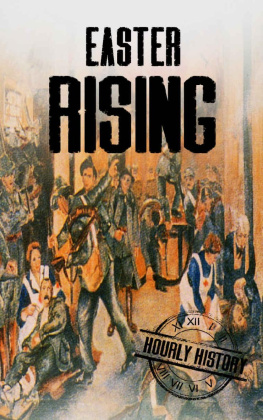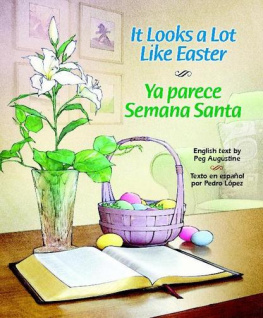Edna Miller - Mousekins Easter Basket
Here you can read online Edna Miller - Mousekins Easter Basket full text of the book (entire story) in english for free. Download pdf and epub, get meaning, cover and reviews about this ebook. year: 1989, publisher: Aladdin Paperbacks, genre: Children. Description of the work, (preface) as well as reviews are available. Best literature library LitArk.com created for fans of good reading and offers a wide selection of genres:
Romance novel
Science fiction
Adventure
Detective
Science
History
Home and family
Prose
Art
Politics
Computer
Non-fiction
Religion
Business
Children
Humor
Choose a favorite category and find really read worthwhile books. Enjoy immersion in the world of imagination, feel the emotions of the characters or learn something new for yourself, make an fascinating discovery.

- Book:Mousekins Easter Basket
- Author:
- Publisher:Aladdin Paperbacks
- Genre:
- Year:1989
- Rating:3 / 5
- Favourites:Add to favourites
- Your mark:
- 60
- 1
- 2
- 3
- 4
- 5
Mousekins Easter Basket: summary, description and annotation
We offer to read an annotation, description, summary or preface (depends on what the author of the book "Mousekins Easter Basket" wrote himself). If you haven't found the necessary information about the book — write in the comments, we will try to find it.
Mousekins Easter Basket — read online for free the complete book (whole text) full work
Below is the text of the book, divided by pages. System saving the place of the last page read, allows you to conveniently read the book "Mousekins Easter Basket" online for free, without having to search again every time where you left off. Put a bookmark, and you can go to the page where you finished reading at any time.
Font size:
Interval:
Bookmark:

A LSO BY J ANE HEALY:
Failure to Connect: How Computers Affect Our Childrens Minds
For Better and Worse
Your Childs Growing Mind: A Guide to Learning and Brain
Development from Birth to Adolescence


SIMON & SCHUSTER PAPERBACKS
Rockefeller Center
1230 Avenue of the Americas
New York, NY 10020
www.SimonandSchuster.com
Copyright 1990 by Jane M. Healy
Introduction copyright 1999 by Jane M. Healy
All rights reserved,
including the right of reproduction
in whole or in part in any form.
S IMON & S CHUSTER P APERBACKS and colophon are registered trademarks
of Simon & Schuster, Inc.
Designed by Irving Perkins Associates
Manufactured in the United States of America
The Library of Congress has cataloged the hardcover edition as follows:
Healy, Jane M.
Endangered minds : why our children dont think
and what we can do about it /Jane M. Healy.
p. cm.
Includes bibliographical references and index.
1. Learning, Psychology of. 2. LearningSocial aspects.
3. LearningPhysiological aspects. 4. Neuropsychology. I. Title.
BF318.H38 1990
155.41315-dc20 9039897
CIP
ISBN-13: 978-0-671-67439-9
ISBN-10: 0-671-67439-1
ISBN-13: 978-0-684-85620-9 (Pbk)
ISBN-10: 0-684-85620-4 (Pbk)
eISBN-13: 978-1-4391-2670-7
Dedicated to Mother Nature
and the giftand responsibilityof neural plasticity
It was a dreary, wet May afternoon ten years ago when I stumbled, bleary-eyed, into the post office to mail the final draft of Endangered Minds. I distinctly remember thinking, Probably no one will ever read this, but at least I got it off my chest!
As it happened, many others shared my concerns, and the book struck an immediate chord both in the United States and abroad. I started to receive notes from teachers that began, So Im not crazy! Kids really are getting harder to teach.... and from parents along the lines of, Thank you for giving us the courage to set some limits on TV in our house and spend better time with our kids. As a congenitally insecure author, I remain eternally grateful to all those who have taken the time to tell me that my ideas have helped. Just last month at a workshop, a participant passed me the following note, typical of many I have received that make all the effort worthwhile:
Five years ago your book saved my career. I was just about to give up teaching, but you inspired me to re-think what I was doing in my classroom, stop blaming my students, and try some new approaches. My job is more fun than ever, and now I want to go back to graduate school to study the brain and learning.
What more could I ask for?
Now, given the opportunity to comment once more, I am heartened that the content of Endangered Minds has stood the test of time and further research, and that greater interest has been aroused about connections between neuroscience and education. I am dismayed, however, that we have not made more headway into curbing toxic electronic and educational environments for children.
I was pretty far out on a theoretical limb when I first presented the hypothesis that childrens brains might be so significantly changed by contemporary culture as to be increasingly maladapted to our traditional notions of school. In the intervening years, however, the concept of cortical plasticitythe process by which the brain shapes itself in response to various environmental stimulihas become a staple of the mainstream press and has even sparked a White House conference.
Given this understanding, the following implication doesnt seem so far-fetched: Children surrounded by fast-paced visual stimuli (TV, videos, computer games) at the expense of face-to-face adult modeling, interactive language, reflective problem-solving, creative play, and sustained attention may be expected to arrive at school unprepared for academic learningand to fall farther behind and become increasingly unmotivated as the years go by. The current educational scene attests to this misfit even more strongly than it did when this book was originally published. Just ask any teacher at any grade level. Moreover, when I warned about the starving executive in , little did I know that the fastest-growing category of learning/behavior disorder was soon to become something called executive function disorder.
Neuroplasticity is now thought to include emotional/motivational as well as cognitive circuits. This would mean that a childs habits of motivation and attitudes toward learning dont all come with the package, but are physically formed in the brain by experience. Thus, if a child is discouraged, defeated, or emotionally abused by parents or teachers, she might develop physical tracks in the system or a negative pattern of neurochemical response that become increasingly resistant to change. When she enters a new learning situation, therefore, she brings a brain predisposed to apathy, negative response, and failure. Those of us who have worked with many such youngsters can readily accept this idea, but we also know that even the most turnedoff kid has potentialit just takes a lot of time and hard work to reroute those maladaptive connections!
We see increasing confirmation of the reality of developmental stages (or waves) and critical/sensitive periods in the brains trajectory of growth. New stages of development may even occur into adulthood. And, hooray!mental activity does indeed continue to improve the brain even into old age; serious mental decline is not inevitable for healthy adults, and those who keep their minds active may be better buffered from the effects of debilitating diseases (e.g., If you get Alzheimers, you may not decline as rapidly.)
I learn about the issues on peoples minds during the question period at lectures and workshops. One of the big questions for parents and teachers continues to be this peculiar epidemic of attention problems, or ADHD. The diagnosis of attention deficit disorder is skyrocketing, and large numbers of children are given prescriptions for stimulant drugs. I have been in schools where teachers told me that up to 50 percent of the students in their classroom are on Ritalin! I know that people who say I told you so are pretty obnoxious, but I must point out that since I originally wrote this book, researchers have confirmed major involvement of the executive systems of the prefrontal cortex and its subcortical connections.
Although, believe it or not, we still await definitive research on media and the brain, I continue to believe this astonishing incidence of illness in kids results from several factors: heredity, pre- and postnatal brain insults from injury or toxic substances, frenetic and electronic mental environments that upshift a childs impulsiveness, lack of appropriate models and limits to teach children to control behavior, language erosion, and media that coach children in being thoughtless and disrespectful. We are asking a lot from our teachers to remediate the cultural debris of large classrooms of kids whose brains have been blasted into academic insensitivity since birth.
To this list, however, I must add school environments that place impossible attentional and academic demands (often in the name of competency) on unprepared brains, and try to cram creative and lively children into boring mental boxes. Consider also some current idiocies such as limiting active play and recess to give kids more time to sit at their desks.
Next pageFont size:
Interval:
Bookmark:
Similar books «Mousekins Easter Basket»
Look at similar books to Mousekins Easter Basket. We have selected literature similar in name and meaning in the hope of providing readers with more options to find new, interesting, not yet read works.
Discussion, reviews of the book Mousekins Easter Basket and just readers' own opinions. Leave your comments, write what you think about the work, its meaning or the main characters. Specify what exactly you liked and what you didn't like, and why you think so.










